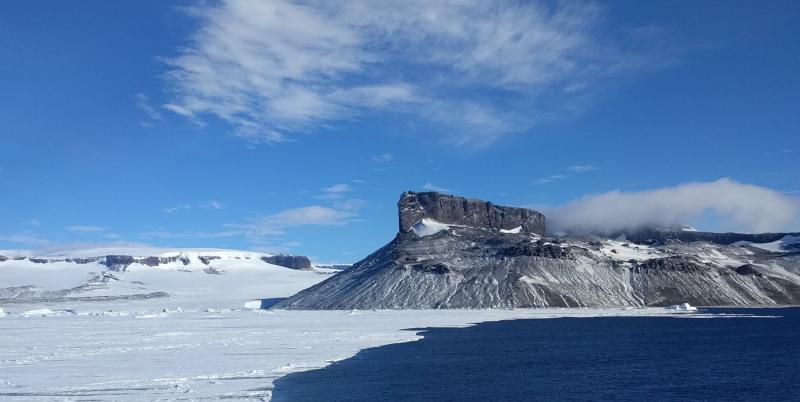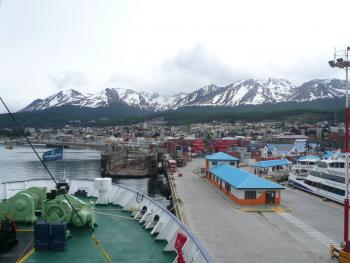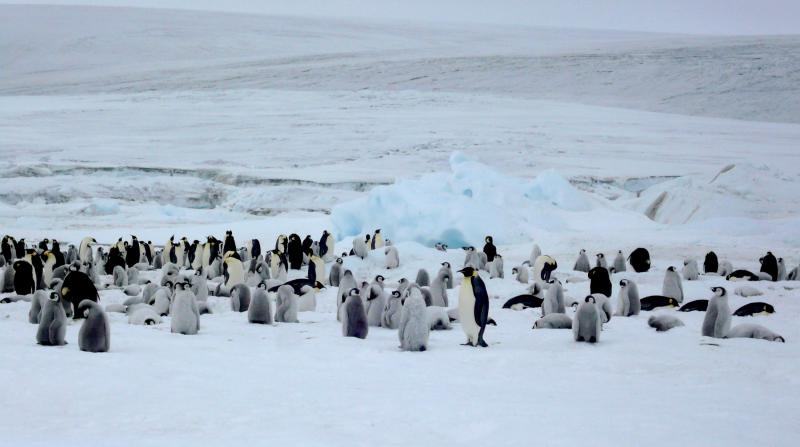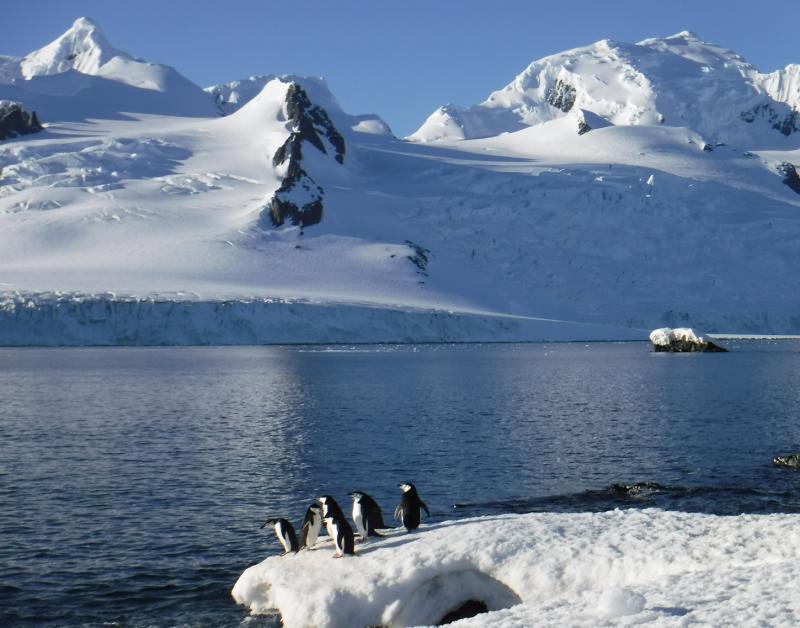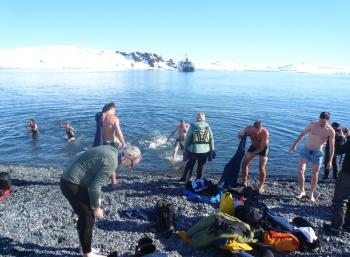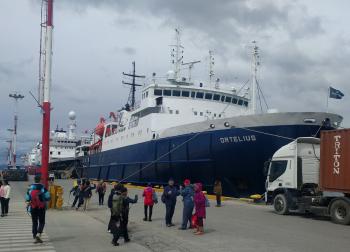Delights triumph over disappointments on an Antarctic expedition cruise
This article appears on page 6 of the June 2018 issue.
One place I had never considered visiting was Antarctica. It always seemed too far away from my world, more of an idea than a location. But when ITN received a press release from Oceanwide Expeditions (US office in Houston, TX; 800/453-7245, oceanwide-expeditions.com) announcing discounted Antarctic cruises for members of the press (airfare not included), the allure of the distant continent was too much to resist.
The trip I found most to my liking was the roughly 2-week “Weddell Sea — In Search of the Emperor Penguin” cruise, Nov. 14-26, 2017. While several cruises go up and down the Antarctic Peninsula, this was the only one that visited an emperor penguin colony and included a helicopter ride — something I’d yet to experience — across the sea ice.
I would soon discover that the frozen, untouched landscape of Antarctica is the most awe-inspiring and the most terrifying place I’ve ever seen.
Underway in Ushuaia
After a seemingly never-ending trip to, through and from Buenos Aires, I found myself in Ushuaia, an alpine city tucked into the southernmost region of Argentina like a prize at the bottom of a cereal box. It is the starting point for most Antarctic cruises.
My one night in Ushuaia was at Hotel Canal Beagle (Av. Maipú 547), which, according to the Immigration official I spoke with in Buenos Aires, does not exist. (Keep a copy of your reservation with you.)
I chose Hotel Canal Beagle because it was practically across the street from the port, which I thought would mean that I had to walk only about 100 feet to drop off my bag when it was time to board my ship the next morning. Actually, it turned out that the bag drop-off point was not at the port but was, instead, about six blocks away (though still close enough to walk to). My comfortable single room cost $143 and included breakfast.
That first day in Ushuaia exemplified Antarctic weather. When I rose at 7 a.m., the sky was clear and it was a bit chilly, reminding me of a crisp, early-winter day. As I walked around the small city in just a thin, long-sleeved shirt, I worked up a sweat.
However, by noon, the wind had picked up, bringing some clouds with it. I entered a restaurant for lunch, and by the time I had finished, it was cold and raining. Jacket weather.
The rain got worse as the day went on, and I boarded the ship in a downpour. Then, as the ship left the port, the sun suddenly came out of the clouds and it was warm enough for just a shirt again.
My ship, the M/V Ortelius, was one of four cruise ships waiting at the port for passengers that morning and one of only two that were rated for sailing through pack ice.
All cabins on the ship were doubles of varying widths. Mine was a window cabin on one of the upper floors and included a sizable bathroom. To skip the single supplement, I readily agreed to be assigned a roommate.
Perhaps there is something about Antarctic explorers, but everyone on the ship got along well with their roomies, despite being strangers before boarding. My roommate turned out to be a friendly German man whose English was only slightly better than my German, but we got along swimmingly.
Penguin sighting
Almost any cruise to Antarctica must start with getting across the Drake Passage. After a 2-day crossing, we finally arrived at the Antarctic Peninsula and headed east into the Weddell Sea toward Snow Hill Island.
It is around that island where emperor penguins make their home on the sea ice, and it was not long before we spotted our first one, a lone individual lying on an ice floe far north of where we expected to see any. The ship slowed and moved closer, and the penguin, apparently a show-off, put on a little performance as we passed, flapping its wings and barking at us before sliding on its belly into the water.
The Ortelius is ice-strengthened but is not an icebreaker, which meant that instead of forging a path through the thick pack ice, the captain and crew had to try to find the route with the thinnest ice. (By the way, if your cabin is on one of the lower decks, the crew will cap your portholes when driving through the ice to make sure that the windows don’t break.)
Soon the ship came to a stop against some thick sea ice while conditions for area excursions were assessed. They could hardly have picked a better place to stop, wedged between the towering Seymour Island and the imposing plateau of James Ross Island, the sun shining so brightly that even a moment without sunglasses was enough to sear your retinas. The warmth of the sun cut through the chill of the ice.
There we remained for a few hours, and the crew used the pause as an excuse to take out a helicopter to search for penguins.
Good news! A large emperor penguin colony was found, which caused a great deal of excitement, especially among the crew. Though penguin sightings are common in the area, finding a colony that is capable of being visited on foot is less so. Both the weather and ice conditions need to fit into very rigid parameters before passengers and crew are allowed to be helicoptered out to a particular site. One crew member shared that he had not been able to make it out to a colony during his three previous cruises.
Helicopter trips out to the penguin colony were scheduled to begin the next morning, but it was then that Antarctica finally decided to live up to its harsh reputation. For the first time of the entire trip, we had a bad morning.
The temperature dropped below freezing, but that alone would not have prevented the helicopters from making their rounds. The 50-mile-per-hour winds and snow certainly did, however.
The wind buffeted my face as I stood on the foredeck that morning, where I stood every morning, making me feel cold for the first time since I had boarded the boat.
The two helicopters were supposed to take groups of 10 (five passengers in each) out to the sea ice, allowing about 40 minutes between groups, but by 10 that morning, the weather had turned into a full-blown blizzard, with visibility limited to about 20 feet. As the blizzard wore on, the resignation of the passengers and crew was palpable; it was clear that no one would be visiting the penguins that day.
The Ortelius makes one trip a year to the Weddell Sea to see this emperor penguin colony, the only ship that has done so for many years. (A second ship, the icebreaker Kapitan Khlebnikov, is scheduled to go in 2018.) However, it had been a number of years since it had done so successfully. Antarctica is not a place that follows your plans.
In 2014, the ship encountered too much ice and could not enter the Weddell Sea. In 2015 and ’16, the sea ice was too thin to land a helicopter, and now, in 2017, the scheduled landing was hampered by a blizzard that came out of nowhere. Of course, each year, the cruise director managed to salvage the trip with other landings at places of interest along the peninsula and nearby islands, but the penguins are always the goal.
We went to bed that night unsure of what the next morning would bring, but everyone tried to remain optimistic.
Awesome sights
I awoke to a clear, blue light streaming in from underneath my window shades. The storm had passed, and the morning was sunny, warm and, best of all, calm. We would be flying out to the penguins today!
Everything happened in a rush. Breakfasts were inhaled, winter clothes were thrown on, cameras were loaded with memory cards. The flights started at 9 and went on until noon, ferrying five excited people each time. Everyone got about an hour and a half on the sea ice south of Snow Hill Island, right along the edge of the colony.
It’s one thing to abstractly know something but a different thing to see something for yourself. For example, everyone I’m sure knows that enormous icebergs patrol the waters around Antarctica, but without seeing one in person, it’s hard to understand just how enormous those icebergs are. To dwarf a boat like the Ortelius, which holds about 100 passengers, is one thing, but to dwarf a small town?! Conceptually, a person can understand that, but until you witness such a sight, the actual enormity of the ice is simply beyond comprehension.
Taking a helicopter to the penguin colony, I was able to see the extent of the sea ice, which was not visible from on board the boat. The ice stretched for miles, with a thickness of more than 10 feet throughout. Reading that, you might get an image in your mind of what I am describing, but you’d be wrong. It’s bigger than that — wider, grander.
Emperor penguins are like that as well. Anyone can do a quick Internet search and find out all kinds of information about the emperors or watch videos online. It’s one thing to know that they are large and imposing birds, but it’s quite another to be within 3 feet of one.
I can tell you about how they can stretch out to about 5 feet tall or that they can weigh 80-plus pounds, but until you see what that means in person, it’s simply not possible to understand what being around a bird that size feels like.
I can confidently say that seeing an emperor penguin “in the flesh” is no less amazing than seeing an erupting volcano, a cascading waterfall or any other miracle of nature.
The colony was like nothing I could have imagined. Having grown up in a non-Antarctic environment, I have a certain understanding of what a bird is; a penguin is not that bird.
Existing in a place with very little to threaten them, the penguins milled about without any cares. Tens of thousands of them, many babies, stumbled around haphazardly within some internally agreed upon borders.
There you will find no nest, no comfort, almost no parenting at all. The chicks wandered about, crying for food each time they found an adult, and were usually ignored. Meanwhile, the more curious adults came right up to the human intruders without any caution, while the less curious simply slid away on fat bellies.
The only time I saw any urgency in a penguin was when one found itself on the helicopter landing site and was forced to actually scurry away by the incoming chopper.
I also discovered that, chicks aside, emperors are not cute. Don’t get me wrong, they are beautiful in the same way that a crocodile or a slow-motion explosion is beautiful, but, like them, the emperor penguin is too powerful to be cuddly.
Their awkward bodies are supported by claws that put the raptors we are familiar with to shame. Their wings are clubs of muscle, their beaks curved scimitars. The only reason a responsible travel company would ever let their guests get as close to the penguins as we did is that the penguins don’t know that they are capable of doing some real damage (or, at least, they don’t have any inclination to do any).
As we’re neither seal nor fish, the impact of a human being on the psyche of a penguin seems minimal. But these strange alien creatures living in the harshest place on the planet turned out to have a sizable impact on this human.
Expect the unexpected
In the schedule, there were four “possible” landings listed (aside from the one to the penguin colony). The trip out to see the penguins replaced at least one of those landings — which no one had any complaints about — and we lost another excursion day stuck on the ship due to the blizzard. But the penguin expedition had given us a taste of life off the ship, and most passengers were eager to taste it again.
Planned for the next day was a landing at Brown Bluff, the only continental landing on the itinerary.
Brown Bluff, itself, was not much different than any other part of Antarctica that I saw — rocky, icy and totally devoid of life. (Well, there was a penguin colony there, but from the ship you would never have known it.) However, it represented a lot of things to the passengers. It was to be our first Zodiac landing, our first chance to put boots on the ground (the penguins we had visited before were on sea ice) and the only chance to walk on geographical Antarctica.
After breakfast, the halls were loaded with passengers excited to zip over to Brown Bluff when the word came down that we were facing a delay. The winds were about 30 knots, and it was determined that it was not safe to load the Zodiacs.
Everyone was disappointed, including the Zodiac drivers, who insisted they could load safely.
We were told to be ready to go in case the wind dropped because the ship would be circling the area all day and it could happen anytime, but the wind never slowed and the day was completely lost.
The bad news continued to roll in. The entrance to the interior bay of Deception Island, the only landing that was actually scheduled in the itinerary (as opposed to listed as optional), was iced over and the ship couldn’t get into the bay. Add to that the tremendous storm that was predicted to hit the Drake Passage during our trip back to Ushuaia, which would force the captain to travel at a reduced speed, meaning we needed one more day than usual to make the crossing. This gave us time for only a single landing: Half Moon Island in the South Shetlands.
The landing was scheduled for 4 in the morning so that the ship could enter the Drake on time. If you ever want to see how desperate a group is to get off a ship, schedule a landing for 4 a.m. and see how many people show up. Almost every passenger was up on time to make the trip.
Half Moon Island is home to an occasionally manned Argentinean base (Cámara), which was closed at the time of our arrival, but, more importantly, it is home to a chinstrap penguin colony. Chinstraps were one of the remaining Antarctic species that we had not yet seen, so it was a treat to be able to visit one of their nesting sites.
These penguins are much more birdlike than the emperors. They build nests of pebbles up on the high rocks of Half Moon, where they squawk and fight and generally make a mess. Since they live much closer to predators, they were much less curious about us than were the emperors, though they still weren’t exactly wary.
Also present on the island were gentoo penguins, a couple of seals and, for the lucky few with good eyes, a single macaroni penguin hiding in the chinstrap colony.
While Half Moon was a nice little place to visit, the most important thing about the stop was that it finally gave the stupidest among us a chance to do a polar plunge. I thought I knew what cold water was — I’ve swum in snowmelt in the Sierras and broken through a (mostly) frozen pond — but until I jumped into that Antarctic water (and you have to jump to get in before your brain points out what a terrible idea it is), I didn’t know what cold was! I will only say that I’m glad I did it, but my toes are not.
Half Moon Island was a blessing and a curse. On the one hand, it got us off the ship for four glorious hours. On the other hand, we had nothing ahead of us for the last three days of our trip but a stormy Drake Passage.
The dreaded Drake
I can see why some Antarctic trips offer a fly-the-Drake option because the crossing is a difficult portion of any trip to Antarctica, especially when you have to do it twice.
Going south, the Drake Passage was excellent for philosophical meanderings. It was amazing to think of the explorers who reached it and said, “You know, let’s just keep going south until we can’t go south anymore.” It helped that, on our first trip across, it was quite calm. (Well, calm for the Drake, that is; the ship was still being rolled by the waves enough for me to require seasickness medication.)
The days were warm and the wind was light, and I spent almost all my free time on the bow. Numerous birds of various species surrounded the boat for the entire trip south, gliding in endless circles. Whales, too, could often be seen, and I watched a solitary dolphin bow-ride in the ship’s wake (even though no one believed me!).
The journey back, however, was a different story. High winds and waves tossed the ship like it was a toy. Water regularly crested over the bow, closing it off to anyone wanting to bird- or whale-watch (not that anyone did in that weather). Thanks to the storm, the ship crawled cautiously north, requiring an extra day in the worst rocking I have experienced on a ship. It was a difficult time.
When we reentered the Beagle Canal, away from the turbulence of the Passage, it was like being able to breathe again.
Life on board
What made the whole trip easier was the crew. Everyone on board, especially the guides, was fantastic. I have not met a more personable, pleasant group of people on any trip.
There was no aloofness. Even though many of them had been to Antarctica before, they were still as excited to be there as the rest of us. Each whale or penguin sighting brought all the crew to the deck along with the guests.
While marveling at an emperor penguin or a particularly picturesque iceberg, you’d often find one of the crew right there next to you with an equally awed look on their face.
The philosophy on the ship was to make the passengers feel involved with the whole cruise-to-Antarctica process. Meal seating was open, and the guides ate along with the passengers. While dining with us, the guides were quick to share experiences, opinions and advice.
Another nice feature was the ship’s open-bridge policy, which allowed passengers to spend time in the wheelhouse with the captain and his officers. At practically any time of the day (as long as complex navigation wasn’t being done), passengers could bird- or whale-watch there (the bridge offered a very nice pair of binoculars for anyone’s use) or learn how to read charts and weather reports with the help of the navigator.
In the end, the camaraderie with the crew was one of the most memorable bits of this cruise.
Trip tips
So how does one prepare for a trip to Antarctica? Here are my tips.
First, find yourself a flight. When researching routing, you’ll notice that almost every trip includes about 30 hours of transit time. However, I found the one set of flights that took only 23 hours, so I booked it immediately, patting myself on the back for being such a savvy traveler.
But that was before I noticed that that travel time was so much shorter because it allowed only 40 minutes to transfer in Atlanta. Realizing that the tickets I bought were nonrefundable — but could be changed for a fee — I tried to change the Atlanta leg of the flight only to discover that every other available flight would make me miss the flight I had booked to Buenos Aires, so I’d have to change that flight too. Panic!
I called Delta to see what they could do and was told, “Don’t worry. We consider any transfer time over 30 minutes to be legal.” I worried, a lot. (I did make my connection, though.)
Then I went to buy some outdoor gear and found out that they didn’t carry my size because, apparently, no 6'3" person has ever needed waterproof pants in all of recorded history — more panic — though I still left the store with at least $400 worth of goods.
I thought I was ready to go, until I looked over my equipment again and, in another panic, headed back to the store to look at gear I worried I might need, then decided I didn’t need it after all and headed home. (This process continued right up to the day I boarded my flight to Buenos Aires.)
Hopefully, if you follow my helpful tips (and learn from my mistakes), you’ll find yourself well prepared for your trip to Antarctica.
Dan Barr paid a discounted press rate of $3,700 for this cruise. A berth on the 2018 Weddell Sea cruise costs $11,400-$14,400 per person, sharing.

